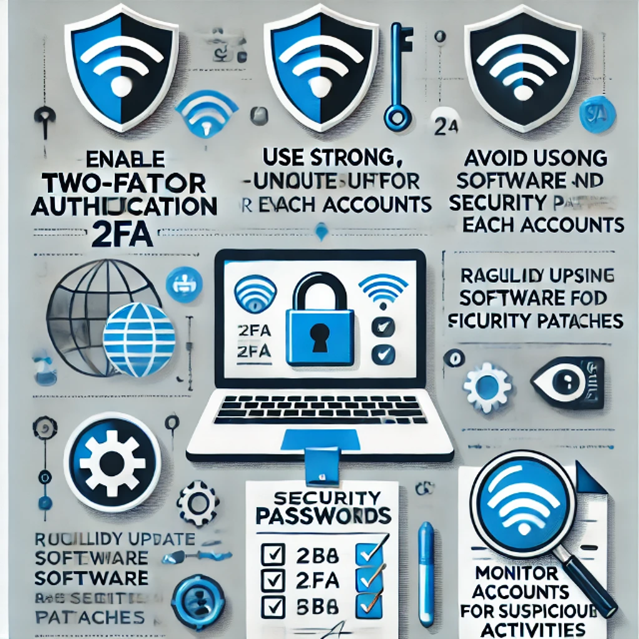Cybersecurity Tips for Digital Financial Tools
Digital Transformation ?? Comments 25/Jul/2025 FriAs digital tools for energy management and green investments become more common, ensuring the security of personal and financial data is critical. Cybersecurity threats such as data breaches, phishing attacks, and malware can compromise sensitive information, making it essential for users to take proactive measures to protect their digital assets. Below are essential tips and strategies to secure your data while using online tools for energy and financial management.
Details
-
The Importance of Securing Personal and Financial Data
o Online platforms for energy management and green investments often handle sensitive information, including financial data (e.g., credit card details, bank account numbers) and personal identifiers (e.g., addresses, income information).
o Without proper cybersecurity measures, users risk exposing this data to cybercriminals, potentially leading to identity theft, financial fraud, or unauthorized account access.
o By adopting secure practices, users can minimize these risks and confidently leverage digital tools to achieve their energy and financial goals.
-
Key Cybersecurity Tips for Using Digital Financial Tools
o Use Two-Factor Authentication (2FA):
-
Enable 2FA on all accounts whenever possible. This adds an extra layer of security by requiring a second form of verification, such as a text message code, email confirmation, or biometric authentication (e.g., fingerprint or facial recognition).
-
Even if your password is compromised, 2FA prevents unauthorized access to your accounts.
o Choose Trusted and Reputable Apps:
-
Only download apps from official app stores (e.g., Google Play Store, Apple App Store) and verify the developer’s credentials.
-
Research the app’s reputation by checking reviews, ratings, and any past security incidents. Trusted apps like Sense, EnergyHub, or financial tools like Mint or Joro typically have transparent security policies and a proven track record.
o Ensure Data Encryption:
-
Look for apps and platforms that use encryption to protect your data. Encryption ensures that even if data is intercepted, it cannot be read by unauthorized parties.
-
Check if the app or website uses HTTPS (indicated by a padlock in the browser’s address bar) for secure communication.
o Create Strong, Unique Passwords:
-
Use a unique password for each platform and avoid reusing passwords across multiple accounts.
-
Choose complex passwords with a mix of letters, numbers, and symbols, and consider using a password manager to generate and store them securely.
o Keep Software and Apps Updated:
-
Regularly update apps, operating systems, and devices to ensure you have the latest security patches. Cybercriminals often exploit vulnerabilities in outdated software.
-
Enable automatic updates to simplify this process.
o Be Cautious of Phishing Attempts:
-
Avoid clicking on suspicious links or downloading attachments from unknown sources. Phishing scams often masquerade as official communications from financial or energy-related apps.
-
Verify the sender’s email address and contact the company directly if you suspect fraud.
o Limit Data Sharing:
-
Only provide the necessary information requested by apps or platforms. Be wary of apps that ask for excessive permissions or data that seems irrelevant to their function.
-
Review privacy policies to understand how your data will be used and stored.
o Monitor Account Activity Regularly:
-
Keep an eye on account activity to detect unauthorized transactions or unusual behavior.
-
Many apps offer alerts for login attempts or financial activity, providing immediate notifications of potential security issues.
-
Practical Example
Securing Data While Applying for Solar Panel Incentives
• A household uses a trusted app to apply for solar panel incentives through a government program. The app collects sensitive data, such as the household’s income details, property information, and bank account for rebate deposits.
• To secure this process:
o The homeowner enables two-factor authentication (2FA) on the app, ensuring that only they can log in.
o They verify that the app uses encryption to protect their data during transmission and storage.
o The household regularly monitors their bank account for any suspicious transactions after submitting their information.
o By following these steps, the household ensures their sensitive data remains secure while benefiting from green energy incentives.
Key Benefits of Cybersecurity for Digital Financial Tools
-
Protection Against Data Breaches:
Implementing strong cybersecurity measures prevents sensitive information from being accessed or stolen by unauthorized parties.
-
Peace of Mind:
Knowing your data is secure allows you to focus on achieving your energy and financial goals without worrying about potential threats. 3. Reduced Risk of Fraud:
Proactively securing your accounts minimizes the likelihood of identity theft, unauthorized transactions, or financial losses.
-
Compliance with Regulations:
Many apps and platforms adhere to data protection regulations, such as GDPR or CCPA, which further safeguard user information when combined with personal cybersecurity practices.
-
Long-Term Financial Security:
Preventing cybersecurity breaches ensures that your financial planning efforts remain effective and uninterrupted.
By prioritizing cybersecurity when using digital financial tools, users can safely manage their energy and financial data, unlocking the full potential of these technologies while minimizing risks.
• Checklist of best practices for securing online accounts.
o Enable two-factor authentication (2FA).
o Use strong, unique passwords for each account.
o Avoid using public Wi-Fi for financial transactions.
o Regularly update software and security patches.
o Monitor accounts for suspicious activities.

Tags: energy cloud digital transformation